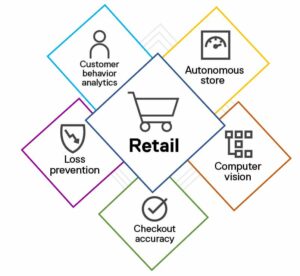It’s Friday afternoon. I’m preparing for a dinner party with friends at my home that evening. As I prep the dessert course, I realize I have forgotten two key ingredients; I need to go to the store and quickly pick them up. I race to the store, breeze through the aisles and grab my items. Success! As I walk to the checkout line, I receive a text from one of my dinner guests stating they are en route to my home. I see a line of people at the store checkout. My mind races… until I remember that this store has cashier-less checkout. I pick up my pace as I push my cart through the exit, knowing the charges will automatically be paid from my account. I place my items into the car and head out. I arrive five minutes before my first dinner guest arrives.
In the last two years, the retail experience has totally changed — and its transformation continues. New customer expectations, spending patterns, savings priorities and shopping behavior are completely redefining the retail experience.
 To keep up, retailers are rethinking everything. They are using technology for breakthrough capabilities such as meeting customer expectations for convenient, seamless interactions. These include streamlining retail operations, overcoming supply chain disruptions and establishing efficient retail systems in order to stay competitive or even outpace the relentless retail competition.
To keep up, retailers are rethinking everything. They are using technology for breakthrough capabilities such as meeting customer expectations for convenient, seamless interactions. These include streamlining retail operations, overcoming supply chain disruptions and establishing efficient retail systems in order to stay competitive or even outpace the relentless retail competition.
For retailers, digital transformation is especially critical at the edge. Bringing compute to where data is created and acted on can enhance operational efficiencies and provide shoppers with excellent in-store experiences. While edge computing opportunities abound, retailers can deploy and gain a competitive advantage today with five trending use cases.
- Autonomous/Cashier-less checkout technology simplifies and speeds transactions. Autonomous store technology placed at the edge enables fully cashier-less stores, where selected items are added to an app-enabled shopping cart, similar to an online experience. Shoppers can then confirm their cart, pay the bill through the app and leave without ever interacting with an associate. Self-checkout or cashier-less stores use sensors and cameras placed throughout the store to scan items as shoppers add them to their carts. This technology uses computer vision and deep learning running at the edge to detect prices and calculate the bill In turn, this allows shoppers to pay and exit without visiting a cashier, and staff can be refocused to improve customer service and inventory management.
- Customer behavior analytics informs customer-centric offers. Advanced analytics at the edge helps retailers understand metrics, such as how frequently a shopper visits a store, the products they prefer and how they respond to marketing, sales and customer service. This helps retailers create more targeted offers.
- Checkout accuracy decreases customer wait times and reduces shrinkage. Advanced artificial intelligence (AI)–enabled video and scanning systems placed at the edge can increase self-checkout accuracy to make the experience faster for customers, flag errors and suspicious transactions to reduce loss.
- Loss prevention helps preserve profits. Monitoring at the edge, powered by AI and analytics, can prevent loss, catch pricing errors and help retailers analyze where loss is occurring so they can prompt cashiers, stockers and customer service to take appropriate actions.
- Computer vision boosts operations and enhances customer experience. Image recognition enables shoppers to scan a product with an app and see current inventory and similar product suggestions and even buy the product and have it brought to them by a store associate. This can help retailers retain sales from shoppers who compare prices online.
Sensor or camera-based customer analytics can detect in-store traffic patterns to help retailers see which promotions are most successful. Known as computer vision, this capability can also count shoppers and study customer behavior anonymously, tracking the customer journey throughout the physical store and enhancing it to improve the in-store experience.
These five use cases are transformational to customer experiences and help retailers win the hearts, minds and loyalty of customers. As a result, digital transformation at the edge holds enormous opportunities for the retail industry. Dell Technologies offers a range of solutions that enable business intelligence and data-driven decisions at the retail edge to help enhance the customer experience and increase operational efficiency to gain an edge over competitors.
To learn more about edge solution for retail and other industries, please visit our site.


